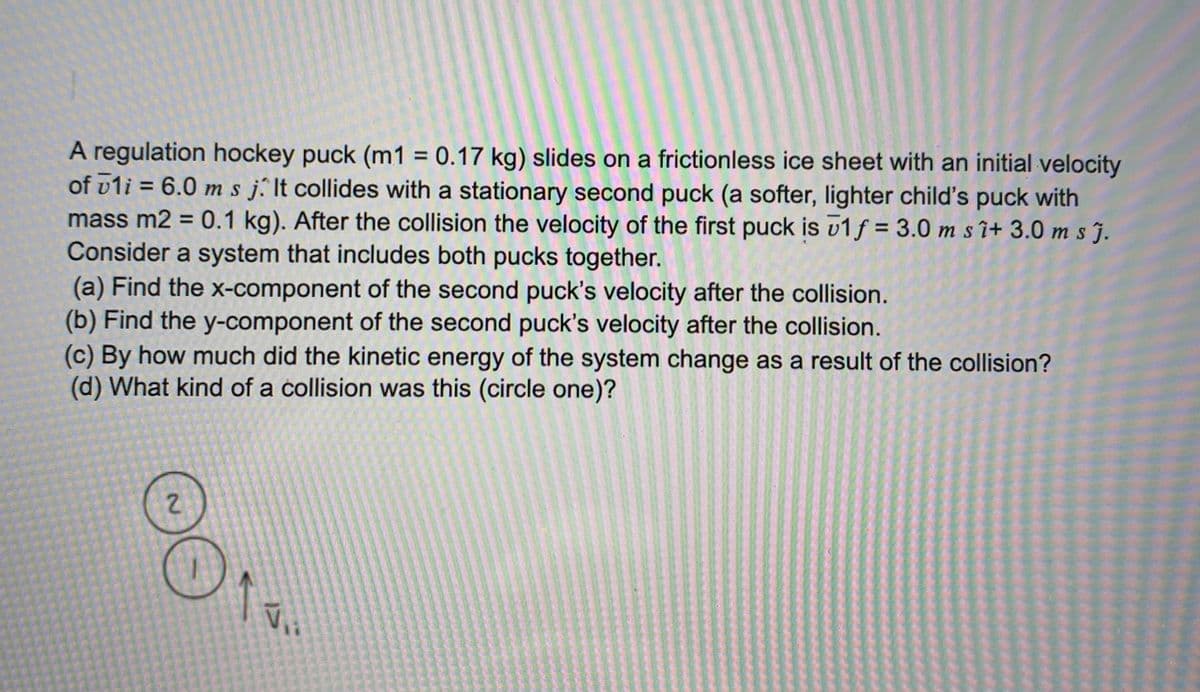A regulation hockey puck (m1 = 0.17 kg) slides on a frictionless ice sheet with an initial velocity of vli = 6.0 m s j. It collides with a stationary second puck (a softer, lighter child's puck with mass m2 = 0.1 kg). After the collision the velocity of the first puck is v1 f = 3.0 m s î+ 3.0 m s j. Consider a system that includes both pucks together. (a) Find the x-component of the second puck's velocity after the collision. (b) Find the y-component of the second puck's velocity after the collision. (c) By how much did the kinetic energy of the system change as a result of the collision? %3D %3D
A regulation hockey puck (m1 = 0.17 kg) slides on a frictionless ice sheet with an initial velocity of vli = 6.0 m s j. It collides with a stationary second puck (a softer, lighter child's puck with mass m2 = 0.1 kg). After the collision the velocity of the first puck is v1 f = 3.0 m s î+ 3.0 m s j. Consider a system that includes both pucks together. (a) Find the x-component of the second puck's velocity after the collision. (b) Find the y-component of the second puck's velocity after the collision. (c) By how much did the kinetic energy of the system change as a result of the collision? %3D %3D
Physics for Scientists and Engineers: Foundations and Connections
1st Edition
ISBN:9781133939146
Author:Katz, Debora M.
Publisher:Katz, Debora M.
Chapter11: Collisions
Section: Chapter Questions
Problem 67PQ: Assume the pucks in Figure P11.66 stick together after theircollision at the origin. Puck 2 has four...
Related questions
Topic Video
Question

Transcribed Image Text:A regulation hockey puck (m1 = 0.17 kg) slides on a frictionless ice sheet with an initial velocity
of vli = 6.0 ms j. It collides with a stationary second puck (a softer, lighter child's puck with
mass m2 = 0.1 kg). After the collision the velocity of the first puck is v1f = 3.0 m s î+ 3.0 m s j.
Consider a system that includes both pucks together.
(a) Find the x-component of the second puck's velocity after the collision.
(b) Find the y-component of the second puck's velocity after the collision.
(c) By how much did the kinetic energy of the system change as a result of the collision?
(d) What kind of a collision was this (circle one)?
%3D
2.
Expert Solution
This question has been solved!
Explore an expertly crafted, step-by-step solution for a thorough understanding of key concepts.
This is a popular solution!
Trending now
This is a popular solution!
Step by step
Solved in 3 steps

Knowledge Booster
Learn more about
Need a deep-dive on the concept behind this application? Look no further. Learn more about this topic, physics and related others by exploring similar questions and additional content below.Recommended textbooks for you

Physics for Scientists and Engineers: Foundations…
Physics
ISBN:
9781133939146
Author:
Katz, Debora M.
Publisher:
Cengage Learning

Principles of Physics: A Calculus-Based Text
Physics
ISBN:
9781133104261
Author:
Raymond A. Serway, John W. Jewett
Publisher:
Cengage Learning

Physics for Scientists and Engineers with Modern …
Physics
ISBN:
9781337553292
Author:
Raymond A. Serway, John W. Jewett
Publisher:
Cengage Learning

Physics for Scientists and Engineers: Foundations…
Physics
ISBN:
9781133939146
Author:
Katz, Debora M.
Publisher:
Cengage Learning

Principles of Physics: A Calculus-Based Text
Physics
ISBN:
9781133104261
Author:
Raymond A. Serway, John W. Jewett
Publisher:
Cengage Learning

Physics for Scientists and Engineers with Modern …
Physics
ISBN:
9781337553292
Author:
Raymond A. Serway, John W. Jewett
Publisher:
Cengage Learning

College Physics
Physics
ISBN:
9781305952300
Author:
Raymond A. Serway, Chris Vuille
Publisher:
Cengage Learning

Glencoe Physics: Principles and Problems, Student…
Physics
ISBN:
9780078807213
Author:
Paul W. Zitzewitz
Publisher:
Glencoe/McGraw-Hill

University Physics Volume 1
Physics
ISBN:
9781938168277
Author:
William Moebs, Samuel J. Ling, Jeff Sanny
Publisher:
OpenStax - Rice University